Common names from other countries
Environment: milieu / climate zone / depth range / distribution range
Ecologia
; intervalo de profundidade 72 - 180 m (Ref. 4), usually 72 - 84 m (Ref. 4). Tropical; 36°N - 8°S, 72°E - 141°E (Ref. 4)
Indo-West Pacific.
Length at first maturity / Tamanho / Peso / Idade
Maturity: Lm 9.6, range 9 - ? cm Max length : 14.0 cm TL macho/indeterminado; (Ref. 122082); common length : 10.0 cm TL macho/indeterminado; (Ref. 4)
It has lengths of 5 to 10 cm, total body length; 0.8 to 3.2 cm, carapace length. (Ref. 4). Occurs in rather shallow waters in Japan, where it sometimes is caught in lobster trap nets; the specimens from India and the Philippines were taken in depths between 72 and 84 m, the juvenile from Amboina came from a depth of "ca. 100 fms" (about 180 m), from a stony bottom (Ref. 191).
Members of the order Decapoda are mostly gonochoric. Mating behavior: Precopulatory courtship ritual is common (through olfactory and tactile cues); usually indirect sperm transfer.
Sekiguchi, N. and S. Okubo. 1986. (Ref. 191)
Categoria na Lista Vermelha da IUCN (Ref. 130435)
Categoria CITES (Ref. 108899)
Not Evaluated
Not Evaluated
Utilização humana
Pescarias: de interesse potencial
| FishSource |
Ferramentas
Fontes da internet
Estimates based on models
Preferred temperature
(Ref.
115969): 23.8 - 27.5, mean 25.8 (based on 49 cells).
